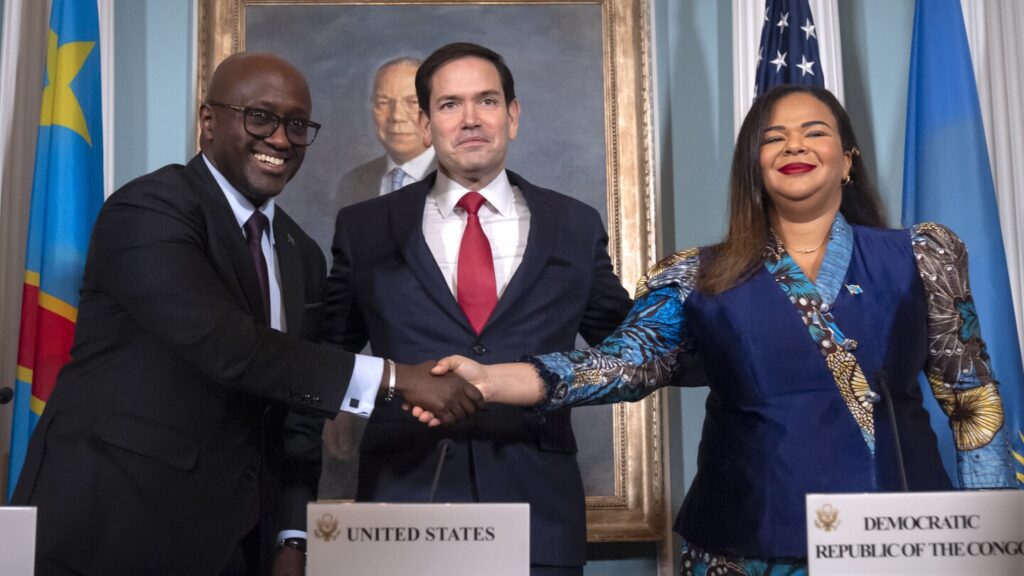
WASHINGTON – The Democratic Republic of Congo and Rwanda have signed a landmark peace deal, facilitated by the United States, in a bid to end decades of deadly conflict in eastern Congo. This agreement also aims to provide U.S. companies access to critical minerals in the region.
Immediate Impact
President Donald Trump, addressing the foreign ministers of both nations at a White House meeting, declared, “Today, the violence and destruction come to an end, and the entire region begins a new chapter of hope and opportunity, harmony, prosperity, and peace.”
The agreement was formalized at the State Department’s Treaty Room, where Secretary of State Marco Rubio emphasized its significance, calling it “an important moment after 30 years of war.”
Key Details Emerge
The conflict in the Central African nation of Congo has been fueled by over 100 armed groups, with the most potent backed by Rwanda, leading to millions of deaths since the 1990s. The deal, while seen as a turning point, faces skepticism as the prominent M23 rebel group claims it does not apply to them.
7 million people have been displaced in Congo, marking it as “one of the most protracted, complex, serious humanitarian crises on Earth,” according to the United Nations.
Trump’s push for mineral access comes amid U.S.-China competition for influence in Africa, with the minerals being crucial for global technology.
Industry Response
Congo’s Foreign Minister Therese Kayikwamba Wagner and Rwandan Foreign Minister Olivier Nduhungirehe expressed optimism but acknowledged the challenges ahead. “Some wounds will heal, but they will never fully disappear,” Wagner noted, emphasizing the expectations of the victims.
“There is no doubt that the road ahead will not be easy,” said Nduhungirehe. “But with the continued support of the United States and other partners, we believe that a turning point has been reached.”
Both ministers praised Qatar’s role in facilitating the agreement, which includes provisions on territorial integrity and disarmament.
By the Numbers
- 6 million people have died due to the conflict in east Congo.
- The U.S. Department of Commerce estimates Congo’s untapped minerals to be worth $24 trillion.
What Comes Next
The peace deal’s success hinges on U.S. security support to help Congo combat the rebels and regain control of key regions. However, the M23 rebels, not directly involved in the agreement, have expressed that it won’t bind them.
Corneille Nangaa, leader of the Congo River Alliance, criticized the agreement for ignoring war crimes and justice for victims, calling it a “trigger-happy proposition.”
Background Context
The conflict traces back to the aftermath of the 1994 Rwandan genocide, where Hutu militias killed hundreds of thousands, leading to a mass exodus into Congo. Rwanda accuses these Hutus of being a threat, while Congo struggles with the ongoing humanitarian crisis.
500,000 to 1 million ethnic Tutsi, as well as moderate Hutus and Twa, were killed during the Rwandan genocide.
Expert Analysis
Christian Moleka, a political scientist at the Congolese think tank Dypol, views the deal as a “major turning point” but stresses that it cannot resolve all conflict issues without addressing justice and reparations.
Hope Muhinuka, an activist from North Kivu, remains cautious, stating, “I don’t think the Americans should be trusted 100%. It is up to us to capitalize on all we have now as an opportunity.”
Regional Implications
The agreement is central to the U.S. strategy to counter China’s influence in Africa, as Chinese companies have dominated Congo’s mineral sector. The deal’s success could reshape regional dynamics, impacting both economic and security landscapes.
“The current draft agreement ignores war crimes and justice for victims,” Moleka said. “This seems like a trigger-happy proposition and cannot establish lasting peace without justice and reparation.”
As the region moves forward, the peace deal’s implementation and its ability to bring lasting stability will be closely watched by the international community.




